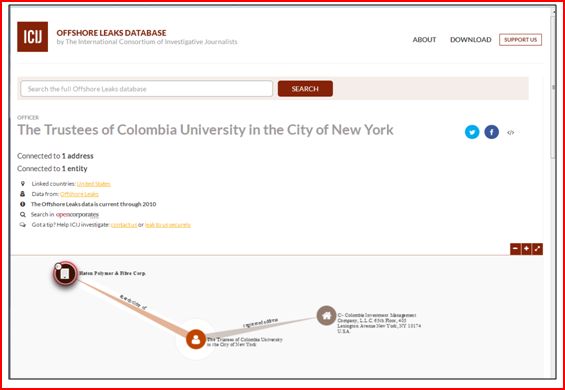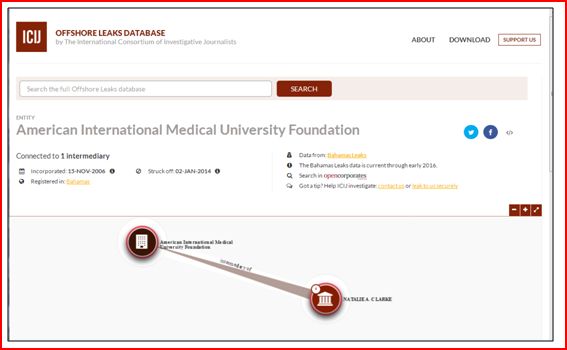
By: Tonya Mead, CFE, CHFI, PI, MBA, MA Educational Psychology
Yes, it appears schools and universities have a portion of their endowment funds stashed overseas (it is not illegal and several entities may have the same or similar names). See below data taken from the Panama Papers database for examples from these education industry sub-sectors.
- traditional higher education university;
- offshore medical school that partners with US universities and hospitals; and
- Christian distant learning program (it is a part of the Seventh-day Adventist education system, the world’s second largest Christian school system).


How did this happen? To analyze the opportunity, capability, incentives and rationale (Fraud Diamond), we must first look at the high cost of college tuition and its drivers.
The Lyndon B. Johnson Act of 1965
Was enacted to move individuals out of poverty. A half century later, it is chaining students to poverty. The funny thing about change is if one doesn’t continually evolve toward positive right action, the catalyst for change becomes a:
- barrier to further growth and advancement. To prevent this, educators like to refer to the term ‘scaffolding’, or
- tool to aid and abet crime. To prevent this, criminologists, auditors, investigators and examiners, want to better manage and control the ‘incentives to commit fraud.’
In the Independent Journal Review, US Rep. Virginia Foxx distilled the higher education problem with these succinct words, “the [Higher Education Act] law has resulted in six types of federal student loans, nine repayment plans, eight forgiveness programs, 32 deferment and forbearance options, higher tuition rates, longer completion times, nearly a trillion dollars in student debt, and 6 million unfilled jobs.” (para 2).
Federal student loans, student debt and high college tuition
Zero Hedge Fund analyzed student debt as I have written on this blog showing, “as of the first quarter of 2017, total student loan debt was increasing the most and had the highest delinquency rate (around 10-11% from 2013 to 2017 [ based upon data for the New York Federal Reserve].”
An Ohio University economist, Richard Vedder, (see previous blog post),”speculated that for every dollar of grant funding for higher education, university systems increase tuition by 35 cents [2]. Similarly, a New York Fed study found that for every dollar obtained in direct and subsidized loans, tuition prices are raised by 65 cents. For every one dollar granted from Pell federal funds, tuition increased by 55 cents [ibid].”
Related articles
- Top Fraud Case 2019: College Admissions Scandal
- Graduation selfies and fraud
- Hack to prove enrollment
- 4 steps to prevent admissions fraud
- $775K hacked from university
- Test Cheating Scandal
- School data breach and tax fraud
- Drugging Medicaid kids and education fraud
- Financial Insolvency vs Fraud in Public Charter Schools
- School Fraud at the State Level
- Four Types of Fraud within the Public Charter Schools
- Hurricanes and School Mismanagement
- Labor, school athletics and fraud
- Student loans and executive bonuses
- For profit fraud rhetoric
- Wage stagnation and student debt delinquencies
- Hack to prove enrollment
- Hedge funds and fraud in education
Vicious cycle must be stopped
High tuition leads to high government subsidized debt and high student loan debt. The dizzying question, Which comes first, the chicken or the egg? and a more mind boggling answer, we may never have the political will to solve; but we must.

A 2015 study titled, “Rich Schools, Poor Students: Tapping Large University Endowments to Improve Student Outcomes,” demonstrated the following [3]:
“Many of the richest universities in the country-sitting on hundreds of million, if not billions, of dollars in tax exempt endowments, and garnering tens of millions of dollars of tax deductible gifts every year receive government subsidies [emphasis added] through current tax laws that dwarf anything received by public colleges and universities.” (page 1, para 3).
Related articles
- Post- Stringent accountability measures for school vendors
- Post- Oversight should be apolitical
- Post- Student loans and executive bonuses
- Post- Gaming graduation rates
As an example the authors state, “we estimate that in 2013, Princeton University’s tax exempt status generated more than $100,000 per full time equivalent student in taxpayer subsidies, compared to around $12,00 per student at Rutgers University (the state flagship), $4,700 per student at the nearby regional Montclair State University, and only $2,400 per student at Essex Community College.” (page1 , para 3).
Sources:
1.“College Aid Means Higher Tuition,” Wall Street Journal, Review and Outlook Section, 20 July, p. A14 , 2015
2.S. Ross, “Who Actually Owns Student Loan Debt?” Investopia, 12 August, 2016. Available: http://www.investopedia.com/articles/personal-finance/081216/who-actually-owns-student-loan-debt.asp
3.K. de Alva and M. Schneider, “Rich Schools, Poor Students: Tapping Large University Endowments to Improve Student Outcomes,” Nexus Research & Policy Center, April, 2015.
Tonya J. Mead, CFE, CHFI, PI, MBA, MA, Certified K-12 Administrator and School Psychologist is author of Fraud in Education: Beyond the Wrong Answer and president of Shared Knowledge, LLC https://ishareknowledge.com
